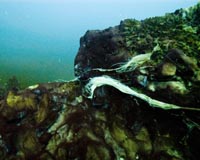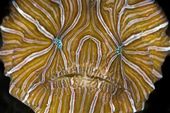
© UnknownIn the oxygen-depleted water, cyanobacteria carry out photosynthesis using sulfur compounds rather than water and give off hydrogen sulfide, the gas associated with rotting eggs.
Researchers are exploring extreme conditions for life in a place not known for extremes. As little as 20 meters (66 feet) below the surface of Lake Huron, the third largest of North America's Great Lakes, peculiar geological formations--sinkholes made by water dissolving parts of an ancient underlying seabed--harbor bizarre ecosystems where the fish typical of the huge freshwater lake are rarely to be seen.Instead, brilliant purple mats of cyanobacteria--cousins of microbes found at the bottoms of permanently ice-covered lakes in Antarctica--and pallid, floating ponytails of other microbial life thrive in the dense, salty water that's hostile to most familiar, larger forms of life because it lacks oxygen.
Groundwater from beneath Lake Huron is dissolving minerals from the defunct seabed and carrying them into the lake to form these exotic, extreme environments, says Bopaiah A. Biddanda of Grand Valley State University, in Muskegon, Mich., one of the leaders of a scientific team studying the sinkhole ecosystems.
Those ecosystems are in a class not only with Antarctic lakes, but also with deep-sea, hydrothermal vents and cold seeps. "You have this pristine fresh water lake that has what amounts to materials from 400 million years ago ... being pushed out into the lake," says team co-leader Steven A. Ruberg of the Great Lakes Environmental Research Laboratory of the National Oceanic and Atmospheric Administration (NOAA).


Comment: Though Heasler admits that "science can't yet explain all of the park's geological quirks" and that there so many things they don't yet understand about Yellowstone's geology, he is quick to reassure the reader that "a volcanic eruption doesn't appear to be imminent". Is this an attempt to sooth people's fears after the recent swarm of earthquakes in the area?